Abstract
The promotion of practicing sport for all through national policies and people`s education for that purpose will lead to a direct or indirect participation of citizens in sports activity. A strategy of sport for all allows numerous different approaches, especially related to priorities; it depends on the economic, socio-cultural and geographical conditions (climate inclusively) of the country. The purpose of this research reflects the importance of growing the practice of sport for all through the development and implementation of some national policies. The methods used in this research include: the analysis and generalisation of data and methodological-scientific sources; pedagogical observation and monitoring; graphical interpretation. It is necessary for public authorities from our country to acknowledge that motor, physical and sports education begins in school and, since every citizen has the right to practice sport, it is an integral part of the culture and a factor of the full human development. In conclusion, considering that the sport is seen as a public service, the public authorities have the responsibility to promote the sport for all by using different programs and political documents, as well as to vote for a sufficient budget favouring sports activities in order to participate in the making and running of sports facilities, starting from the requirements studied by local authorities that must encourage the development of practicing the sport for all.
Keywords: Sport for allnational policiespromotionsports equipmentsports facilities
Introduction
Generally, sport must be considered a public service for community; the public authority assigns constant actions for promoting sports for all (Sport and Local Authorities, 1979). The national programs and policies must be encouraged by the participation of population and voluntary – public organisations, in order to create some coordination structures for citizens’ practicing of physical activities. According to national reports there is a direct connection between the growth of sports participation and the existence of sport for all policies.
Also, sport is an instrument of international agreement among people and cities. In this way the development of sports activities claims a program based on the participation of all interested parts, especially the public authorities and organisations. The methods of this collaboration depend on the competent authorities and the social and cultural traditions of the country. In order to meet the sports needs of the population, the field of sport should count on the subsidy and financial support of the public and associative bodies. The collaboration should be flexible for a good efficiency.
In the Republic of Moldova, the sport for all is governed by the Law on Physical Culture and Sport no. 330-XIV of 25.03.99 (Guvernul Republicii Moldova, 1999). According to this law, the propagation of physical culture and sport on a wide scale is an assignment for all authorities, economic agents and public associations. The national health policy acknowledged by the Government Resolution no. 886 of 06.08.2007 indicates that the development of physical activities practising by citizens is one of the governmental priorities. While “The actions meant to reduce the adynamia and to increase the physical activities will be addressed to all the groups of population, including those involved in sedentary activities or processes with insignificant physical expenses. There will be practiced rest breaks for the employees with sedentary and monotonous activities” (Guvernul Republicii Moldova, 2007).
Problem Statement
There are two prerequisites regarding the promotion of sport for all: education and services. The education aims to inform the population about the importance of physical activities for maintaining and promoting a healthy lifestyle. The proper information not only raise the awareness of the citizens about the importance of physical activities for the improvement of life quality and for the increase of social welfare but also contribute to the long term development of physical culture and sports in our country (Strong et al., 2005; Hanțiu, 2005). The awareness about the importance of sport for keeping an optimal level of welfare (physical, emotional, psychological and social one) underlies the proactive attitudes in regard to physical activities (Urichianu, 2017).
The term of “sport” appeared at the end of the 19th century in the context of physical education promotion in the English schools. It was the cornerstone of Thomas Arnold’s theory and referred to the education made through challenge and competition. Pierre de Coubertin takes over and develops the ideas of Arnold: “sports pedagogy” ... Nothing is solid or stable in physical education if not achieved in collaboration with the sport (Dragnea et al., 2006). Sport spread fast all over the world. In 1936, A. B. Stiven (quoted by Bette and Rutten, 1995) finds out that the technical terms related to sports field became a common fortune of all nations. Sport is defined as “an organized game accompanied by physical effort, performed through a formal structure, made in a context of formal and clear rules of behaviour and procedures and watched by the audience (Dictionary of Sport and Exercise Sciences, 1991); the specific development of a sport improves the absolute and relative strength, muscle elasticity and mass, specific strength, according to sport requirements, movement time and reaction time, coordination and flexibility, creating the capacity for execution of all movements easily and fluently (Bompa, 2002).
European Sports Charter (1992) provides the framework for a sport policy to which all the European countries have subscribed. This charter is the reference point for public authorities and sports organizations. The governments – in collaboration with sports movement - commit themselves to provide to their citizens the possibility to practice sport according to well-defined conditions stipulated in article no. 13. (Le Conseil de l’Europe et le sport 1967-91, 1992)
The Republic of Moldova intends to join the Council of Europe and will adhere to its recommendations concerning the sport. The Republic of Moldova adopts the European Sports Charter, but also other documents related to the European civilisation of sport that reveal the following elements: sport must be a common good, it is a culture factor, a way to develop the human being, a factor of health enhancement (Dragnea et al., 2006).
Proclaimed in 1975, the concept of “sport for all” is the fundamental expression of the European Council philosophy of sport. This generous view, which generated the unprecedented process of democratisation of sport in Western Europe, is currently spread in the entire Europe. It is supplemented by the increasing use of EUROFIT, an easy method of measurement of physical skills of children and adults as well (Dominteanu, 2011).
The European Council takes action against the negative issues in sport – doping and violence – by means of the conventions, punitive legal instruments which can operate even beyond the geographical limits of Europe, like in the case of doping (Chaker, 1999).
Research Questions
Will the promotion of adequate national policies in the field of physical culture contribute to the development of sport for all, to the creation of conditions for the implementation of special national and local programs and to the increase of population health?
Which are the basic responsibilities that the local public authorities should fulfil in order to promote the sport for all practicing?
Purpose of the Study
The main purpose of the study is the promotion of sport for all through national policies in the Republic of Moldova.
Research Methods
The methods used in this research are reflected through: analysis and generalisation of data concerning methodological-scientific sources, observation and pedagogical monitoring, graphical interpretation.
The research was conducted from 2005 to 2011 with the support of the state institutions involved in the organization and development of sport for all and performance sport.
The following indicators were analysed in order to highlight the promotion area of sport for all in the Republic of Moldova:
capital renovations of sport facilities at national level;
distribution of sport halls in the Republic of Moldova;
number of sport halls in the north and central part of the Republic of Moldova;
number of sports facilities in Chisinau and UTA Gagauziya.
Findings
According to the Demographic and Health Study in the Republic of Moldova, achieved in 2005 by the Ministry of Health in collaboration with other international organizations, such as UNICEF, UNFPA and CNSPMP, only 1.9% of population of our country (as a rule, the men) practice intensively physical culture and sport and only 5.3% practice the physical activity. In this context, the population of the Republic of Moldova risks to become hypo dynamic, since only 8-10% of teenagers are included in the first group of health, meaning they are healthy and well trained persons, most of the teenagers being included in the second group of health: they are healthy and untrained teenagers (40.8%-45.5%) (Ministerul Sănătății, 2005).
In order to promote the practicing of sport for all, our government and the economical agents should be involved in the management of the investments intended for the total improvement of sports facilities. Moreover the public authorities of the Republic of Moldova should be aware of the fact that the athletic, physical and motor education starts from school and any citizen has the right to practice sport, which is an integral part of the culture and a factor for the full development of the human being (Potop & Jurat, 2016). Thus, the sports facilities should be open for the wide public after the school hours (development of sport for all) and a coordinating body should establish the schedule for the use of these facilities depending on the needs of the different categories of beneficiaries.
Figure
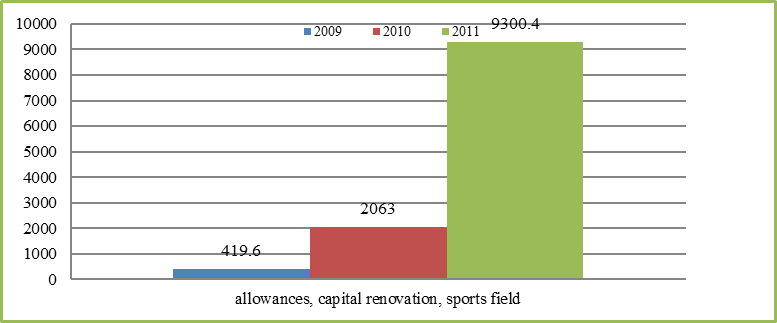
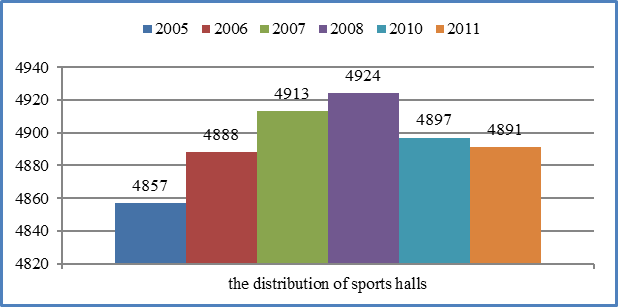
In Figure
We graphically present hereby the number of sports halls per area (north, centre, Chisinau, UTA Gagauziya) (Figures
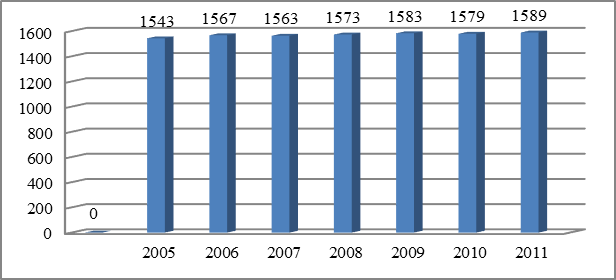
We notice in Figure
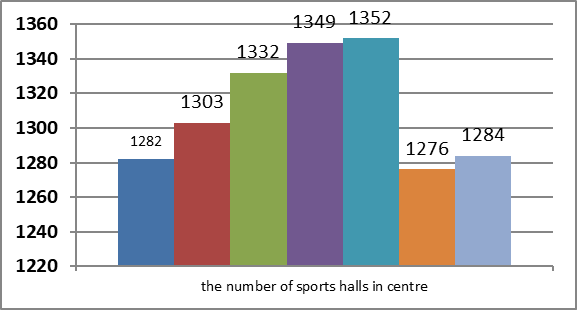
In the centre of the Republic of Moldova the most sports facilities were built or arranged during 2008-2011, for values ranging from 1300 to 1360.
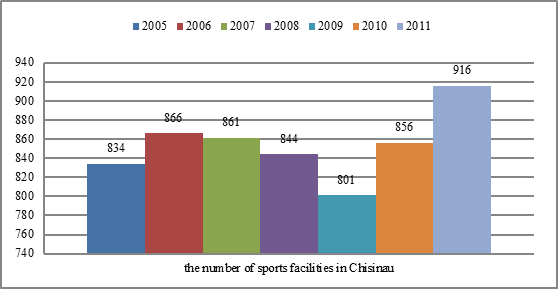
Taking into account the elements mentioned above, the outdoor and indoor spaces are the following:
Stadiums with stands for 500 persons or more;
Sports grounds (lands and fields);
Sports halls;
Swimming pools.
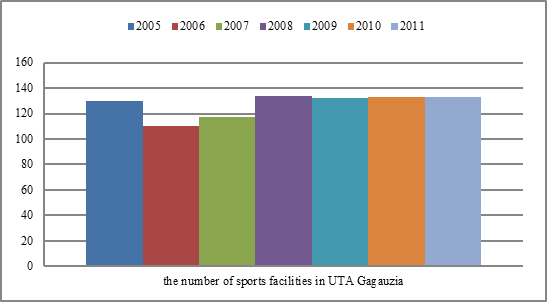
The sports grounds include also the artificial football fields, private sports centres, fields located in schools etc. The national policies focus on ensuring the operation of a national/community mechanism to encourage citizens to take part in regular sports activities (Budevici-Puiu, 2018).
Figure
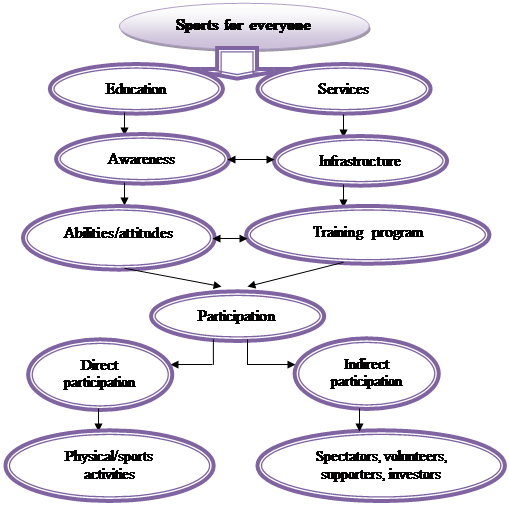
Moreover, the role of sports managers often seems to be neglected (Cornescu, Mihăilescu, & Stanciu, 1998; Dănăiaţă, Bibu, & Predişcan, 2002). The human resources must be considered a support for every sports policy, acting in agreement with the local authorities that must meet their citizens’ requirements on a daily basis (Manolescu, 2001). The role of authorities and local communities in the field of sport has several levels: research; planning; organisation, including administration, promotion and also an assessment on what was done before. The research must be practical, efficiently pragmatic and to take account of different views of the potential beneficiaries. An important issue that research should deal with is to find out if the sports facilities should be built close to their beneficiaries or these ones should be attracted to the sports centres with multiple sports activities on the outskirts of the towns (Thomas, Nelson, & Silverman, 2010).
It is important that the national sports policies authorise the building of sports and leisure time complexes in the cities or next to the cities in order to offer a wide range of joint free activities for families (avoiding to separate the members of a family and serving as a meeting point for them); the access ways for the public must be also taken into consideration (buses, tracks for bicycles, mopeds etc.).
The sport for all must be considered a public service and that is why it has to obtain funds like the other public services (health, education etc.) while it can also get supplementary budgetary resources (Potop & Jurat, 2016). However the beneficiaries of these sports services should pay small fees or financial participations but their amount must not impede the democratisation of sports practicing.
The sports policy entails the necessity of long term planning coordinated with the other public life departments, in order to obtain a good integration policy. At the same time the high cost of constructions, sports facilities and fields often exceeds the possibilities of sports organizations. This situation is specified in the European Sports Charter, namely “the equipment of the public facilities is a public duty if the clubs cannot finance this investment” (Le Conseil de l’Europe et le sport 1967-91, 1992).
In order to have a sustainable development of the sport for all, the authorities should also take into consideration the use of the natural resources of the city (rivers, parks, channels) or the outskirts places such as forests and green spaces.
Conclusion
In conclusion, given that the sport is seen as a public service, the public authorities have the responsibility to promote the sport for all by using different programs and political documents. They must vote for a sufficient budget favouring sports activities in order to participate in the construction and running of sports facilities, based on the requirements studied by local authorities that must encourage the development of practicing the sport for all
Thus, public authorities must ensure to all citizens equal chances for sport and leisure time activities. The adequate conditions for the development of the sport for all and performance sport could lead to a large number of achievements in the field of performance sports.
The basic responsibilities fulfilled by the local public authorities contributed to the creation of a well-structured plan for the development of physical culture and sport, the implementation of special programs for promoting the sport for all, the modernisation of the material and technical resources needed by the sport for the masses, popularisation of physical exercises within the population of different ages (including invalids, children with disabilities and orphans) and creation of a fresh view of media regarding the promotion of sport as a healthy lifestyle.
Acknowledgments
We express our gratitude to the public institutions – Ministry of Youth and Sport, Ministry of Finance and Ministry of Health of the Republic of Moldova – that provided us with the necessary documents for the achievement of this study.
References
- Bette, K. H. & Rutten, A. (Eds.) (1995). International sociology of sport: Contemporary issues. Stuttgart: Naglschmid.
- Bompa, T. O. (2002). Periodizarea: Teoria și metodologia antrenamentului. București: Ex Ponto.
- Budevici-Puiu, L. (2018). Extending the competence of the sports volunteers. The European Proceedings of Social & Behavioural Sciences, XXXVI, 367-373. Retrieved from http://dx.doi.org/10.15405/epsbs.2018.03.49
- Chaker, A. N. (1999). Études des législations nationales relatives au sport en Europe. Strasbourg: Éditions du Conseil de l’Europe.
- Conseil de l’Europe. (1992). Le Conseil de l’Europe et le sport 1967-91 (Vol. I-II). Conseil de l’Europe.
- Cornescu, V., Mihăilescu, I., & Stanciu, S. (1998). Management – Baze generale. București: Actami.
- Dănăiaţă, I., Bibu, N., & Predişcan, M. (2002). Management – Bazele teoretice. Timişoara: Mirton.
- Dictionary of sport and exercise sciences. (1991). Sport (Definition). Champaign, IL: Human Kinetics.
- Dragnea, A., Teodorescu, S., Stănescu, M., Bota, A., Șerbănoiu, S., & Tudor, V. (2006). Educație fizică și sport – Teorie și didactică. București: FEST.
- Dominteanu, T. (2011). Consiliul Europei și sportul. Marathon, 3(1). Retrieved from http://www.ase.ro/marathon/revista/pdf/vol3/1/DumitreanuTeodora.pdf
- Hanțiu, I. (2005). Studiu asupra motricității umane. Oradea: Editura Universității din Oradea.
- Guvernul Republicii Moldova. (2007). Hotărâre nr. 886 din 06.08.2007 cu privire la aprobarea Politicii Naționale de Sănătate. Retrieved from http://old2.ms.gov.md/sites/default/files/programe_strategii/1047-politica20nationala20de20sanatate1.pdf
- Guvernul Republicii Moldova. (1999). Legea cu privire la cultura fizică și sport nr. 330 - XIV din 25.03.99. Retrieved from http://www.cnas.md/libview.php?l=ro&id=548&idc=183
- Manolescu, A. (2001). Managementul resurselor umane (Ed. a 3-a). București: Editura Economică.
- Ministerul Sănătății. (2005). Studiul demografic și de sănătate din Republica Moldova. Retrieved from https://dhsprogram.com/pubs/pdf/FR178/FR178-Romanian.pdf
- Potop, L., & Jurat, V. (2016). Evaluation of “Physical Education and Sport” curricular area in primary school. The European Proceedings of Social and Behavioural Sciences, XXVII, 663-668. Retrieved from http://dx.doi.org/10.15405/epsbs.2017.07.03.78
- Sport and local authorities. (1979). [Scientific and Methodological Seminar, Madrid, doc. CDDS /79/33].
- Strong, W. B., Malina, R. M., Blimkie, C. J., Daniels, S. R., Dishman, R. K., Gutin, B., … Trudeau, F. (2005). Evidence-based physical activity for school – Youth age. Journal of Pediatrics, 146(6), 732-737.
- The Chinese University of Hong Kong (August 2009). Consultancy study on sports for all – Participation patterns of Hong Kong people in physical activities. Summary report. Retrieved from https://www.lcsd.gov.hk/en/sportforall/common/pdf/study_abr_082009_e.pdf
- Thomas, J. R., Nelson, J. K., & Silverman, S. J. (2010). Research methods in physical activity (6th ed.). Human Kinetics.
- Urichianu T., S. (2017). Motivation of higher education students for practicing sports activities. In National Conference Proceedings “Sports Nutrition from Education to Performance” (Vol. 1, pp. 24-29). Bucharest: Romanian-American University.
Copyright information

This work is licensed under a Creative Commons Attribution-NonCommercial-NoDerivatives 4.0 International License.
About this article
Publication Date
16 February 2019
Article Doi
eBook ISBN
978-1-80296-054-9
Publisher
Future Academy
Volume
55
Print ISBN (optional)
-
Edition Number
1st Edition
Pages
1-752
Subjects
Sports, sport science, physical education
Cite this article as:
Manolachi, V. (2019). Promotion Of Practicing Sport For All Through National Policies. In V. Grigore, M. Stănescu, M. Stoicescu, & L. Popescu (Eds.), Education and Sports Science in the 21st Century, vol 55. European Proceedings of Social and Behavioural Sciences (pp. 543-551). Future Academy. https://doi.org/10.15405/epsbs.2019.02.68
